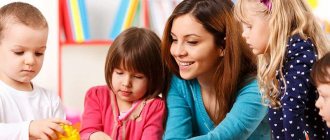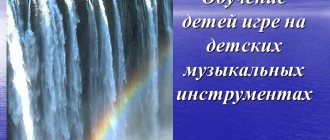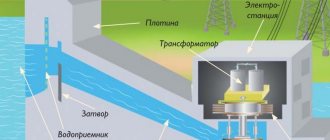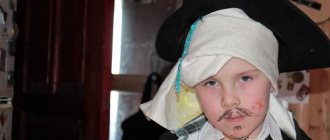Presentation “What is water?”
- April 27, 2013
Competition "Master of Multimedia Technologies - 2013"
Nomination "Multimedia technologies in the pedagogical process in preschool educational institutions"
During preschool childhood, the child discovers the natural world. Supporting preschoolers' natural interest in all living things, the teacher leads children from acquaintance with nature to understanding it.
The child’s ability to explore the world around him is provided by activity, since it is an important condition and means of cognition. To be active means to be active! The more complete and varied a child’s activity is, the more significant it is for the child, the more successful his development is.
Prominent Russian psychologist S.L. Rubinstein considers observation as the result of meaningful perception, during which the development of mental activity occurs. He connects the development of various forms of perception and observation with content. An important question is about the content of observations - what a child can and should see, what features of natural objects to notice.
Purpose : this presentation provides clarity - a visual display in the lesson. Introduce children to the properties of water.
Objectives : the presentation work is structured in such a way that after a conversation (with viewing slides) about the need for water for all living things, it will smoothly integrate into the topic of the lesson. The teacher, moving step by step, tells where water is found, conducts experiments, and clearly demonstrates the phenomena of inanimate nature on slides. Develops logical thinking, visual and auditory attention, creative imagination.
Efficiency : consolidates knowledge about inanimate nature, contributes to the creation of an information and communication environment, meets modern requirements.
Practical significance:
- A visual introduction to the need for water for humans, animals and plants.
- Familiarization with the phenomena of inanimate nature, with the properties of water.
- Poetic part.
Place of use of multimedia material: it can be used both by teachers of preschool institutions as visual material in a lesson to familiarize themselves with the natural phenomenon - water, and by parents to organize cognitive and research activities of children at home.
Equipment: Computer, multimedia projector.
PROGRESS OF THE CLASS
Organize children's attention and create play motivation. To the sounds of “The Sound of Water,” a SCIENTIST FROM THE MAGICAL LABORATORY enters in a robe and a quadrangular academic cap.
- Hello guys! I came to visit you, my name is Scientist, and today I will tell you about one of the greatest riches of our planet! But first, guess the riddle:
Introduction to the game situation, preparing children for the topic of the lesson
SLIDE No. 1
She is in the lake and in the puddle She is circling above us like a snowflake, She is also boiling in our kettle, She is running in the river, gurgling (water).
– Guess what we’re going to talk about today? We will talk about water. I want to invite you to my magical laboratory and tell you about the great miracle - water. There we will become young scientists. Let's conduct experiments to understand how unique it is. Do you know what a laboratory is? (This is the place where scientists conduct experiments and conduct experiments).
– And to get there you need to answer several questions.
SLIDES No. 2,3,4,5,6,7,8.
– Tell me, why does a person need water? (A person drinks water, washes, cooks, waters gardens, gets rid of dirt with water).
– But not only humans need water! (Water is needed by animals, plants, insects, birds, fish. Without water, living things cannot survive).
- That's right, now let's play a game.
Igra “Who needs water?”
Each child chooses a picture depicting various objects of nature (animal, plant, person - a small child, a woman, etc.) and tells why the person depicted in the picture needs water (other children can add).
- Well done! Let's go to our laboratory, here you will find out what properties it has, but first let's remember the rule for handling water:
Since we are dealing with water, let’s roll up our sleeves with confidence. If you spill water, it’s no problem, a rag is always at hand.
- Let's stand in a circle, hold hands and close our eyes.
(CD music “Sound of the Surf” sounds).
- Here we are in the water laboratory!
SLIDES No. 9, 10 (magic laboratory, globe).
– It is difficult to find a place on earth where there is no water. Water is everywhere: in oceans, seas, rivers and lakes. Water is found in the earth, water is found in plants, animals, even humans. Look at our planet, this is how it looks from space. Why is there so much blue on it? (These are seas, oceans, lakes, rivers, this is all water).
- That's right, now:
Have you heard about water? They say she is everywhere! Like an icicle freezing. Fog creeps into the forest. It's called a glacier in the mountains. It curls like a silver ribbon. We are accustomed to the fact that water is always our companion!
Slides No. 11, 12, 13.
– Tell me what you know about water, where it is found in nature (in seas, oceans, rivers, lakes, swamps).
SLIDES No. 14,15,16,17.
– Tell us what inanimate phenomena are associated with water. (Dew, fog, cloud, steam, rain, snow, ice, frost).
Conclusion: water is one of the most important substances for nature; it is found everywhere, even inside a living organism. Water not only gives you drink, but also feeds you; you can’t cook a single dish without water. Water generates electricity and helps transport goods. Although it seems that there is a lot of water on the planet, living organisms only need fresh water, and there is not very much of it in nature. And for this reason it must be protected.
Activate children's knowledge about water, develop children's social skills, prove the correctness of their opinions, consolidate children's knowledge about the properties of water.
SLIDE No. 18 (Three states of water).
- Let's see what state water can be in in nature.
EXPERIMENT No. 1 “WATER-LIQUID”.
– Pour water from one glass to another (from smaller to larger). You see how our water flows. This means it is LIQUID and does not have its own shape.
SLIDE No. 19 (liquid water).
EXPERIMENT No. 2 “WATER IS STEAM” (The scientist brings in a thermos with hot water).
– What comes out of a thermos when water boils? (Steam)
- Where did the steam come from in the jar - we poured water?
Conclusion: When heated, water turned into STEAM.
SLIDE No. 20 (pairs).
– What will happen next?
EXPERIMENT No. 3 “STEAM IS WATER” (brings cold glass to the stream of steam).
- Look what happened to the glass. Where did the water droplets on the glass come from? When the steam hit the cold glass, it turned into water again.
Conclusion: steam turns into WATER when cooled.
SLIDE No. 21 (steam turns into water when cooled). This is what happens in nature.
Physical education moment.
– Making scientific discoveries is not an easy task, so there are breaks in laboratories to rest. It would be nice for us to rest a little. What do our young scientists think? Let's step away from our laboratory tables and go to the carpet.
(Children are located on the carpet in random order.)
While stretching our lower back, we will not rush. Turn right, turn left, look at your neighbor.
(Turns in different directions) To become even smarter, we will slightly twist our neck. Once and twice, once and twice, my head began to spin.
(Rotate your head right and left) One, two, three, four, five. We need to stretch our legs.
(Squats) Finally, everyone knows how to always walk in place.
(Walking in place) There are benefits from warming up! Well, it's time to sit down
– Every day the sun heats the water in the seas and oceans, just as it heats up in kettles of water.
– Water turns into steam. As steam, tiny, invisible droplets of moisture rise into the air. The higher the steam rises, the colder the air becomes. The steam turns back into water. The droplets all come together and form a cloud.
SLIDE No. 22 (cloud).
– When there are a lot of water droplets, they become very heavy for the cloud and fall as rain on the ground.
SLIDE No. 23 (rain).
– What do water droplets turn into in winter? (Into snowflakes).
EXPERIMENT No. 4 “WATER IS SOLID”. (Ice trays are brought in and each child is given an ice cube).
– In winter, another amazing phenomenon occurs on the surface: the water has turned into ice. Look how hard ice is, which means water can become SOLID.
SLIDES No. 24,25,26 (snowflakes, ice).
- Now let’s hold it in our hands, what’s going on? From the warmth of our palms, it began to melt as if heated, and again turns into a LIQUID STATE
- This is how the water repeats its path. This is called the water cycle in nature.
(Use of artistic expression as a means of consolidating acquired knowledge about the water cycle in nature).
SLIDES No. 27,28 (water cycle in nature).
Water travels in nature, It never disappears. It will turn into snow, then into ice, It will melt and go hiking again. Suddenly it soars into the sky and turns into rain. Look around, take a closer look at nature. You are surrounded everywhere and always by this sorceress-water.
- Let's rest a little again and do self-massage.
Clean water flows, We know how to wash ourselves. (Children rub their palm against their palm.) Wash your nose, wash your mouth (rub the wings of your nose). Wash your neck, wash your ears. (Rub your earlobes with your fingers). Afterwards we dry off. (stroke forehead).
- Well, my dears, our trials are coming to an end. Were you interested in being a scientist? (Yes). Let's summarize our acquired knowledge. Do you guys now know what types of water there are? (Liquid). And if you freeze it, what does the water turn into? (Into the ice). What about when heated? (In steam).
Reflection
– Now I will award each of you with a badge, it says “Young Scientist”. This means that you have learned a lot of new things, but you won’t stop there, and you will continue to learn a lot of new and interesting things about our planet called Earth. Conduct wonderful and unusual experiments.
(Put stickers in the shape of droplets on the chest of each child. Create conditions for the psychological comfort of children).
“And before you leave my magical laboratory, I want to treat you to spring water.”
Droplets travel not only through the air and the ground, but also go underground. There they absorb all the healing properties of the earth and come to the surface in the form of springs. This water becomes the most healing. It gives vigor and strength to all living things.
SLIDE No. 29 (springs). (Treating children with spring water)
– Now let’s hold hands again, close our eyes and listen to the sound of the water, and move to our d/s. Goodbye, my young scientists, see you again!
(music “The Sound of Water”).
Presentation for class
Author: Dolomanyuk Guzel Usmanovna, teacher, MADOU No. 358, Kazan. Teaching experience 3 years.
On the topic: methodological developments, presentations and notes
This summary presents a method of children's experimentation. Children's experimentation is a method of practical, purposeful action, with the help of which one's own life is formed.
Interesting activity on Experimenting with children. Note to educators.
- Improve children’s understanding of the various properties of water. - Contribute to the accumulation in children of specific ideas about the properties, forms and types of water; - Clarify and consolidate knowledge d.
Program content Educational objectives: To promote the accumulation in children of specific ideas about the properties, forms and types of water; To clarify and consolidate children’s knowledge about the water cycle in the area.
SUMMARY OF CLASSES WITH CHILDREN 6-7 YEARS OLD.
Develop children's understanding of the various properties of water.
Source
On the topic: methodological developments, presentations and notes
LESSON SUMMARY IN A PREPARATORY GROUP on the topic “WATER. WATER CYCLE IN NATURE. PROPERTIES OF WATER"
This summary presents a method of children's experimentation. Children's experimentation is a method of practical, purposeful action, with the help of which one's own life is formed.
Project “Water!Water! - Water all around!”
It is very important to teach people, and especially children, our future generation, to be careful about water. How uncomfortable we feel when suddenly the water tap turns out to be empty! And at the same time.
Methodological development for the project “Water + I = friends” - Game-activity with water in the 1st junior group on the topic: “The Journey of Water.”
METHODOLOGICAL DEVELOPMENT FOR THE PROJECT “WATER + I = friends” SYNOPSIS OF GAME-ACTIVITY WITH WATER IN THE 1ST JUNIOR GROUP ON THE TOPIC: “THE JOURNEY OF WATER”. Teacher of the 1st category of GDOU No. 72 Krasnosel.
"Water. Three states of water. How to keep water clean"
Abstract of a joint educational activity on cognitive and research activities for children in the preparatory group for school.
LESSON SUMMARY IN A PREPARATORY GROUP ON THE TOPIC: “WATER. WATER CYCLE IN NATURE. PROPERTIES OF WATER" USING EXPERIMENTAL RESEARCH TECHNOLOGY.
Interesting activity on Experimenting with children. Note to educators.
Open thematic lesson “Queen-Water” or “Water, water, water all around” for young children.
Plan of an open lesson on the usefulness and importance of water for children 2-3 years old.
“Water, water, water all around” (experiments with water)
In our world we cannot do without water. She is the basis of our entire life. But besides supporting our body, water can perform many different functions, including entertainment and education.
Source
On the topic: methodological developments, presentations and notes
Date: February 21, 2012 Participants: children of the preparatory group Conducted by: educational psychologist Panova M.M. Purpose: to promote formation.
Goal: To remind children of the content of a familiar fairy tale, to encourage them to pronounce and repeat individual words and phrases after the teacher, to cultivate a love of fiction. Objectives: ·.
Every year in the fall, namely in November, the whole world celebrates the wonderful holiday of Mother's Day. Mom is the dearest and closest person who will always understand and support. These small scenarios for...
When compiling the speech map, material from Nishcheva N.V. was used. The speech map is compiled in such a way that when printed it folds into a small book, it is convenient to fill out even for a young student.
Card index of physical education minutes in the second junior group; Card file of gymnastics after sleep in the second younger group; Card index of outdoor games in the second junior group; Card index of morning exercises.
: develop an interest in theatrical acting and a desire to take an active part in theatrical activities; encourage action; cultivate friendly relations, a desire to help each other. Teach children how to.
Source





